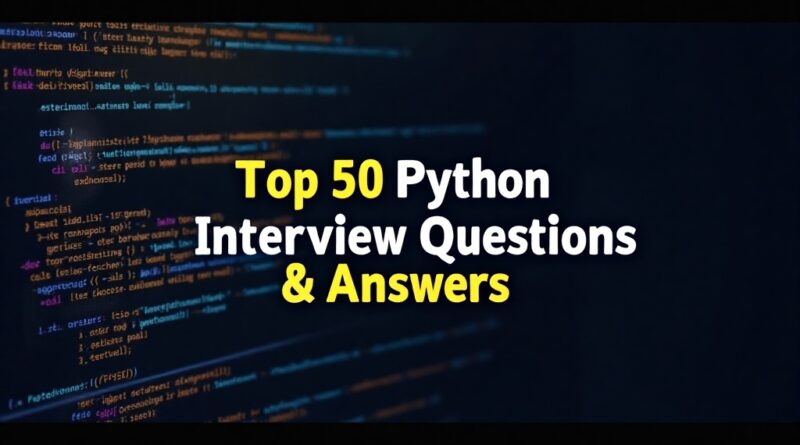50 most common Python Interview Questions and Answers
✅ 50 Essential Python Interview Questions and Answers (With Detailed Explanations & Examples)
Python is one of the most in-demand programming languages for modern software development, data science, AI, automation, and web applications. If you’re preparing for a technical interview, understanding Python’s core concepts is essential.
As an interviewer, I often assess candidates not only on their ability to write code but also on how clearly they understand the fundamentals.
Let’s dive into the top 50 Python interview questions you must know – with detailed answers and real-world examples to help you master each concept.
🔹 1. What is Python?
Answer:
Python is a high-level, interpreted, general-purpose programming language known for its clean syntax, readability, and wide range of applications like web development, data science, AI, and scripting.
🔸 Example:
print("Hello, Python!")
🔹 2. What are the key features of Python?
Answer:
-
Easy to read and write
-
Dynamically typed
-
Supports multiple programming paradigms (OOP, functional, procedural)
-
Extensive standard library
-
Platform-independent
-
Open-source and community-driven
🔹 3. What is the difference between a list and a tuple?
Answer:
| Feature | List | Tuple |
|---|---|---|
| Mutability | Mutable | Immutable |
| Syntax | [] |
() |
| Use case | Frequent updates | Fixed data sets |
🔸 Example:
my_list = [1, 2, 3]
my_tuple = (1, 2, 3)
🔹 4. How is memory managed in Python?
Answer:
Python uses automatic memory management via:
-
Reference Counting
-
Garbage Collection
-
Memory pools for small objects (managed by Python’s private heap)
🔹 5. What are Python’s data types?
Answer:
-
Numeric:
int,float,complex -
Sequence:
list,tuple,range -
Text:
str -
Set:
set,frozenset -
Mapping:
dict -
Boolean:
bool -
Binary:
bytes,bytearray
🔹 6. What is the difference between Python 2 and Python 3?
Answer:
-
Python 3 uses
print()function, while Python 2 used a statement -
Python 3 has better Unicode support
-
Division behaviour differs (integer vs float)
-
Python 2 is now deprecated
🔹 7. What are Python’s control structures?
Answer:
Python supports:
-
Conditional:
if,if-else,if-elif-else -
Loops:
for,while, withbreak,continue,pass
🔸 Example:
for i in range(3):
print(i)
🔹 8. What is indentation in Python?
Answer:
Unlike other languages that use {} or ;, Python uses indentation to define blocks. This improves readability but requires strict syntax discipline.
🔹 9. What is a Python function?
Answer:
A block of reusable code defined using the def keyword. Supports parameters, return values, and scope.
🔸 Example:
def greet(name):
return f"Hello, {name}"
🔹 10. What are *args and **kwargs?
Answer:
-
*args: Passes a variable number of non-keyword arguments -
**kwargs: Passes a variable number of keyword arguments
🔸 Example:
def demo(*args, **kwargs):
print(args)
print(kwargs)
🔹 11. What is a lambda function?
Answer:
An anonymous, single-expression function created using lambda. Useful for short operations.
🔸 Example:
square = lambda x: x * x
🔹 12. What is list comprehension?
Answer:
A concise way to create lists using a loop inside brackets.
🔸 Example:
squares = [x*x for x in range(5)]
🔹 13. Explain Python’s object-oriented features.
Answer:
Python supports:
-
Classes & Objects
-
Encapsulation
-
Inheritance
-
Polymorphism
🔹 14. What is the difference between is and ==?
Answer:
-
ischecks identity (memory location) -
==checks equality (value)
🔸 Example:
a = [1]
b = a
print(a == b) # True
print(a is b) # True
🔹 15. What is Pythonic code?
Answer:
Code that follows Python’s best practices, emphasises readability, and uses idiomatic features like comprehensions and unpacking.
🔹 16. What are Python modules and packages?
Answer:
-
A module is a single Python file (
.py) containing functions, classes, or variables. -
A package is a directory that contains multiple modules and an
__init__.pyfile.
🔸 Example:
# math.py
def add(a, b):
return a + bimport math
print(math.add(2, 3))
🔹 17. What is the difference between global and local variables?
Answer:
-
Local variables are defined inside functions and are accessible only within them.
-
Global variables are defined outside all functions and are accessible everywhere.
🔸 Example:
x = 10 # Global
def func():
x = 5 # Local
print(x)
🔹 18. What is recursion in Python?
Answer:
Recursion occurs when a function calls itself to solve smaller subproblems.
🔸 Example (factorial):
def factorial(n):
if n == 1:
return 1
return n * factorial(n - 1)
🔹 19. How are exceptions handled in Python?
Answer:
Python uses try, except, else, and finally blocks to handle exceptions.
🔸 Example:
try:
result = 10 / 0
except ZeroDivisionError:
print("Cannot divide by zero!")
🔹 20. What are Python decorators?
Answer:
Decorators are functions that modify the behaviour of another function without changing its code.
🔸 Example:
def decorator(func):
def wrapper():
print("Before function")
func()
print("After function")
return wrapperdef greet():
print(“Hello!”)
🔹 21. What is the difference between shallow copy and deep copy?
Answer:
-
Shallow copy creates a new object but inserts references to the original objects.
-
Deep copy creates a new object and recursively copies all nested objects.
🔸 Example:
import copy
list1 = [[1, 2], [3, 4]]
list2 = copy.deepcopy(list1)
🔹 22. What are Python’s built-in data structures?
Answer:
-
List: Ordered, mutable sequence
-
Tuple: Ordered, immutable sequence
-
Set: Unordered, unique elements
-
Dict: Key-value pairs
🔹 23. What is __init__ In Python?
Answer:__init__ is the constructor method that gets called when an object is created from a class.
🔸 Example:
class Person:
def __init__(self, name):
self.name = name
🔹 24. What is a generator?
Answer:
Generators return items one at a time using yield, preserving memory.
🔸 Example:
def my_gen():
yield 1
yield 2
yield 3
Also Read,
50 Most Common C Language Interview Questions and Answers
50 Most Common C Language Interview Questions and Answers
🔹 25. What is the purpose of self?
Answer:self represents the instance of the class and allows access to its attributes and methods.
🔹 26. Explain Python’s garbage collection.
Answer:
Python automatically deallocates memory using reference counting and a cyclic garbage collector in the gc module.
🔹 27. What are Python’s file handling operations?
Answer:
-
Open:
open('filename', 'r') -
Read:
.read(),.readlines() -
Write:
.write() -
Close:
.close()
🔸 Example:
with open("sample.txt", "r") as file:
content = file.read()
🔹 28. What is the purpose of with statement in Python?
Answer:
Ensures proper resource handling. Automatically closes files or connections even if errors occur.
🔹 29. How does Python handle memory management?
Answer:
Through:
-
Automatic garbage collection
-
Dynamic typing
-
Private heap space
🔹 30. What are Python’s comparison operators?
Answer:
-
==,!=: Equality/Inequality -
<,<=,>,>=: Less/Greater comparisons -
is,is not: Identity
🔹 31. What are iterators and iterables?
Answer:
-
An iterable is any object with
__iter__()like lists, tuples. -
An iterator is an object with
__next__()that returns items one by one.
🔹 32. What is slicing in Python?
Answer:
Used to extract parts of sequences like strings and lists using [start:stop:step].
🔸 Example:
my_list = [0,1,2,3,4,5]
print(my_list[1:4]) # [1, 2, 3]
🔹 33. What is a Python set?
Answer:
Unordered, mutable collection of unique elements.
🔸 Example:
my_set = {1, 2, 3}
🔹 34. What is a dictionary in Python?
Answer:
An unordered collection of key-value pairs.
🔸 Example:
person = {"name": "Alice", "age": 25}
🔹 35. What is a classmethod vs staticmethod?
Answer:
-
classmethod takes a class as the first argument (
cls) -
staticmethod doesn’t take implicit arguments
🔸 Example:
class Demo:
@classmethod
def from_class(cls):
return cls()def greet():
print(“Hello”)
🔹 36. How do you handle JSON in Python?
Answer:
Using the json module: json.load(), json.dumps() to parse or stringify JSON.
🔹 37. What are Python’s logical operators?
Answer:
-
and: True if both are true -
or: True if at least one is true -
not: Inverts boolean
🔹 38. What are Python’s special methods?
Answer:
Also called dunder methods (like __str__, __repr__, __len__) — allow operator overloading and custom behaviour.
🔹 39. What is duck typing?
Answer:
“If it looks like a duck and quacks like a duck…” — behaviour over type checking.
🔹 40. What is the difference between @staticmethod a normal function?
Answer:
A @staticmethod lives inside a class but doesn’t access class or instance data.
🔹 41. What is the difference between del, remove(), and pop()?
Answer:
-
delDeletes by index or entire object -
remove()Deletes by value -
pop()Removes and returns the item
🔹 42. How do you handle exceptions with multiple types?
Answer:
Use multiple except blocks or a tuple of exceptions.
🔸 Example:
try:
risky_code()
except (ValueError, TypeError):
handle_error()
🔹 43. What are *args and **kwargs used for?
Answer:
To pass a variable number of arguments in functions.
🔹 44. What is a context manager?
Answer:
Manages resources with __enter__ and __exit__, like in with open().
🔹 45. How is multithreading handled in Python?
Answer:
Via threading module — but due to the GIL, true parallelism is better with multiprocessing.
🔹 46. What is GIL (Global Interpreter Lock)?
Answer:
A mutex in CPython that allows only one thread to execute Python bytecode at a time.
🔹 47. What is the purpose of the enumerate() function?
Answer:
Returns both the index and the item during iteration.
🔸 Example:
for index, value in enumerate(['a', 'b']):
print(index, value)
🔹 48. What is a Python virtual environment?
Answer:
An isolated workspace for Python projects to manage dependencies independently using venv or virtualenv.
🔹 49. What is PEP 8?
Answer:
Python Enhancement Proposal 8 – the official style guide for writing clean and readable Python code.
🔹 50. How do you test Python code?
Answer:
Using built-in unittest, pytest, or doctest frameworks to write and run test cases.
🎯 Conclusion
These 50 Python interview questions and answers cover foundational to advanced topics, ensuring you’re well-prepared for coding interviews. Practice each concept with the examples given, and aim to write clean, Pythonic code that’s easy to maintain.
📤 Stay Updated with NextGen Careers Hub
📱 Follow us on Instagram
📺 Subscribe us on YouTube
Please share our website with others: NextGenCareersHub.in

Please do follow us on social media platforms for more updates




Comments are closed.